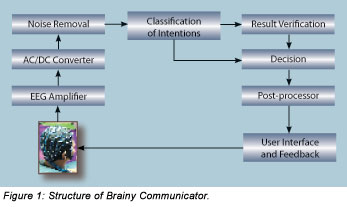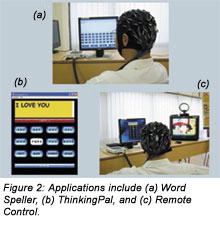|
by Cuntai GUAN
 rain-computer interface (BCI) is a fast-growing emergent technology in which researchers aim to build a direct channel between the human brain and the computer. Of the two general approaches to recording brainwaves in BCI — invasive and non-invasive — the former provides precise control but requires electrode implantation into the brain to capture neuron signals. Non-invasive methods may find wider application because of their greater convenience and safety. rain-computer interface (BCI) is a fast-growing emergent technology in which researchers aim to build a direct channel between the human brain and the computer. Of the two general approaches to recording brainwaves in BCI — invasive and non-invasive — the former provides precise control but requires electrode implantation into the brain to capture neuron signals. Non-invasive methods may find wider application because of their greater convenience and safety.
State-of-the-Art BCI Research
"ocked-in" people, those with complete paralysis, require BCI as a communication device immediately. Niels Birbaumer and his group at Eberhard-Karls-University of Tuingen, Germany, developed a spelling system called the Thought-Translation Device (TTD) to help patients with amyotrophic lateral sclerosis (also known as Lou Gehrig's disease) to communicate (see "Tapping Brain Waves" INNOVATION, Vol 4 No 3 (2004): 62). A professional who has lived on a respirator for the past several years could successfully write a letter with TTD.
Brainwaves consist of several rhythms owing to their frequency components. Among various rhythms, an individual can voluntarily regulate his or her µ and ß rhythms, which revolve around 10Hz and 20Hz, respectively. Relying on this phenomenon, Jonathan Wolpaw and his team at the Wadsworth Center of the New York State Department of Health have been working on developing BCI systems for a two-dimensional cursor control that can provide disabled people, such as those with spinal-cord injuries, to control robotic arms or prostheses.
Neurophysiologists can consistently map motor-nerve systems to specific brain areas. For instance, hand movement would result in a compression of µ or ß rhythms at the counter lateral hemisphere of the vertex. Gerts Pfurtscheller and his colleagues at Graz University of Technology, Austria, developed various BCIs based on the detection of so-called event-related rhythm synchronisation and desynchronisation by a subject's imaging limb movement.
The advantage of motor imagery BCI, compared to self-regulation of slow-cortical potential or µ/ß rhythms, is that users can quickly master it as it is relatively intuitive. A challenge arises, however, when researchers try to recognise correctly what action users are attempting by reading their EEG data because of low noise-to-signal ratio. Klaus-Robert Muller and his Fraunhofer FIRST team in Germany successfully applied machine-learning methods to BCI by letting the machine learn instead of the person.
Another important brain signal BCI research widely studies and deploys is P300 potential. When an anticipatory or a rare event becomes interspersed with frequent events, it creates a measurable difference at the central or parietal sites of the vertex. This positive potential typically occurs about 300 milliseconds after the event occurs. Lawrence Farwell and Emanuel Donchin proposed the first P300 BCI; Donchin and others later improved its performance and built a prosthesis based on it. Recent research showed that, with proper design, a P300-based BCI could run 1.5 bits per second, the highest information-transfer rate in all BCIs to date.
Brainy Communicator
Singapore's Institute for Infocomm Research (I2R) has developed an assistive communication and control system dubbed “Brainy Communicator.” It aims to provide a way for people with complete loss of limb movement to access the computer to perform such tasks as writing a letter, sending an email, or controlling home appliances like televisions, stereos, air-conditioners, and so on. Users of Brainy Communicator have only to look at one button of many displayed on the screen, and a non-invasive recording device, the electroencephalogram (EEG), will read their intentions from their brainwaves.
 Based on the P300 BCI technology, Brainy Communicator comprises several components, as depicted in Figure 1. Based on the P300 BCI technology, Brainy Communicator comprises several components, as depicted in Figure 1.
An EEG Amplifier, together with the electro-cap, facilitates EEG acquisition. An AC/DC-current converter transforms brainwaves into digital data for the computer to process. Noise removal eliminates such irrelevant information as electrical signals due to an eye blink or other bodily movements. Classification translates brainwaves into commands, and advanced-machine-learning approaches, such as the support-vector machine, recognise the users’ intentions from their brainwaves.
Result verification and decision components decide when and what result to give. A post-processor forms proper output signals according to differences in application. For example, when the Brainy Communicator is configured as a word speller, the screen displays the output as text whereas if a remote control is built, an infrared transmitter sends the output to a remote device. Finally, a good interface is needed to guide the subject in interacting with the system.
Application Prototypes
 The I2R team has built a few applications based on Brainy Communicator. Figure 2(a) shows a word speller with a virtual keyboard on the screen. The user can select any symbol from the 44 keys by simply looking at that symbol. It is possible to "type" a letter in about 20 seconds with up to 99% accuracy, or he or she can achieve 95% accuracy with input speed increased to 13 seconds per symbol. A better user-interface design can further improve this input speed, such as the ThinkingPal shown in Figure 2(b), a word speller based on a T9 keypad. To retain similar accuracy, the input speed of ThinkingPal can be improved to 4–5 seconds per symbol. Figure 2(c) shows another application, Remote Control, which can be used like the word speller with similar accuracy. The I2R team has built a few applications based on Brainy Communicator. Figure 2(a) shows a word speller with a virtual keyboard on the screen. The user can select any symbol from the 44 keys by simply looking at that symbol. It is possible to "type" a letter in about 20 seconds with up to 99% accuracy, or he or she can achieve 95% accuracy with input speed increased to 13 seconds per symbol. A better user-interface design can further improve this input speed, such as the ThinkingPal shown in Figure 2(b), a word speller based on a T9 keypad. To retain similar accuracy, the input speed of ThinkingPal can be improved to 4–5 seconds per symbol. Figure 2(c) shows another application, Remote Control, which can be used like the word speller with similar accuracy.
The I2R group is engaged in an ongoing joint-research project with the Singapore Society for the Physically Disabled to develop Brainy Communicator further. They will also determine whether a system will work for an able-bodied person as well as for the disabled.
BCI is attracting attention from multidisciplinary fields such as computer science, neuroscience, psychology, mathematics, engineering, and others. It has potential application in many areas, among them, communication and control devices for the neurologically disabled, new gaming protocols, biofeedback, and monitoring of mental states.
BCI is in its infancy. Scientists still face difficulties and limitations in applying this technology to real-world situations. Among the challenges are low signal-to-noise ratio in brainwaves, high subject variability in performance, levels of interaction between human and computer, low numbers of possible decisions per command, slow response time, and a painstaking training process.
Researchers in this area focus on developing theories, algorithms, and experimental paradigms to learn the correct brain signals for desired actions with plausible neurophysiological explanations, to discover effective algorithms that recognise mental activities with accuracy and speed, and to design for users appropriate feedback so they can adapt to the system quickly. When some of those limitations are overcome, we can expect to see the emergence of a broad range of BCI applications.
For more information contact Cuntai Guan at ctguan@i2r.a-star.edu.sg
 Click here to download the full issue for USD 6.50 Click here to download the full issue for USD 6.50
|


 rain-computer interface (BCI) is a fast-growing emergent technology in which researchers aim to build a direct channel between the human brain and the computer. Of the two general approaches to recording brainwaves in BCI — invasive and non-invasive — the former provides precise control but requires electrode implantation into the brain to capture neuron signals. Non-invasive methods may find wider application because of their greater convenience and safety.
rain-computer interface (BCI) is a fast-growing emergent technology in which researchers aim to build a direct channel between the human brain and the computer. Of the two general approaches to recording brainwaves in BCI — invasive and non-invasive — the former provides precise control but requires electrode implantation into the brain to capture neuron signals. Non-invasive methods may find wider application because of their greater convenience and safety.
 Based on the P300 BCI technology, Brainy Communicator comprises several components, as depicted in Figure 1.
Based on the P300 BCI technology, Brainy Communicator comprises several components, as depicted in Figure 1.
 The I2R team has built a few applications based on Brainy Communicator. Figure 2(a) shows a word speller with a virtual keyboard on the screen. The user can select any symbol from the 44 keys by simply looking at that symbol. It is possible to "type" a letter in about 20 seconds with up to 99% accuracy, or he or she can achieve 95% accuracy with input speed increased to 13 seconds per symbol. A better user-interface design can further improve this input speed, such as the ThinkingPal shown in Figure 2(b), a word speller based on a T9 keypad. To retain similar accuracy, the input speed of ThinkingPal can be improved to 4–5 seconds per symbol. Figure 2(c) shows another application, Remote Control, which can be used like the word speller with similar accuracy.
The I2R team has built a few applications based on Brainy Communicator. Figure 2(a) shows a word speller with a virtual keyboard on the screen. The user can select any symbol from the 44 keys by simply looking at that symbol. It is possible to "type" a letter in about 20 seconds with up to 99% accuracy, or he or she can achieve 95% accuracy with input speed increased to 13 seconds per symbol. A better user-interface design can further improve this input speed, such as the ThinkingPal shown in Figure 2(b), a word speller based on a T9 keypad. To retain similar accuracy, the input speed of ThinkingPal can be improved to 4–5 seconds per symbol. Figure 2(c) shows another application, Remote Control, which can be used like the word speller with similar accuracy.
 Click here to download the full issue for USD 6.50
Click here to download the full issue for USD 6.50